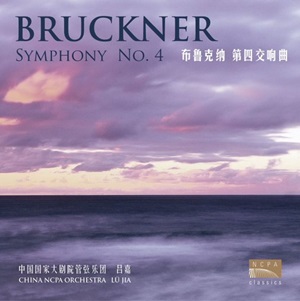
Anton Bruckner (1824-1896)
Symphony No 4 in E-flat major ‘Romantic’ (ed. Nowak, 1878-80 version)
China NCPA Orchestra/Lü Jia
rec. live composite, 2024, China NCPA Concert Hall, Beijing
NCPA Classics 81620220-1 [79]
The unusual feature of this recording is the extended timing for the finale, matched only by Celibidache in some of his dozen recordings of the Fourth Symphony; most conductors take around twenty minutes – Karajan and Tennstedt two or three minutes more – but not the nearly twenty-nine minutes of Lü Jia here. While the hallmark of this set has been the leisureliness of his tempi, that has not impacted upon the tension he has been able to sustain. This is surely something of a gamble in this last release in the NCPA series of nine symphonies. The Andante movement, too, is quite slow, similar to Tennstedt in his superb 1989 live recording with the LPO, but Lü Jia takes the finale at a more conventional twenty-two minutes.
The horn-call opening, beautifully executed, generates plenty of mystery and expectation. What I now recognise as Lü Jia’s trademark talent for creating a broad sweep is soon apparent, the grandeur of his phrasing enhanced by the sonority of his orchestra. I trust he will not continue to follow too many conductors who have embraced the “groanalong” habit, which is also intermittently faintly audible. I risk repeating the observations I have made about the previous releases in this series of live recordings: this is “monumental” Bruckner which never lapses into stodginess and extraordinarily high artistic, technical and sonic standards are maintained. The principal horn continues to contribute immaculately to this most songful of Bruckner’s first movements; we traverse sunlit glades, tramp along mountain paths and survey broad vistas before the rolling, crashing climax of what I – perhaps fancifully – envisage as a pounding waterfall of sound in the conclusion while the horns blaze heavenward. It may have become a cliché, but this symphony does not bear the sobriquet “Romantic” for nothing; it is Bruckner’s testament to Nature and God’s creation.
There is a lovely glow to the cello melody which opens the slow movement. It is not perhaps “Andante” as that is generally understood. I can well understand some listeners favouring a brisker pace of the kind favoured by such fine interpreters as – perhaps surprisingly – Böhm and, more recently, Honeck and Hindoyan, all under sixteen minutes. But Lü Jia’s approach is consistent with his interpretative stance across the nine symphonies and he certainly creates a suitably intense atmosphere and the coda is magnificent.
If the Andante is leisurely, there is no lack of bite or spring in the outer sections of the ‘Hunting Scherzo’ which shares timings virtually identical with Tennstedt, Karajan, Blomsted, Schaller et al; there really is much less viable scope in such music for variation. The trio rocks gently in contrast and the movement concludes in a satisfyingly thunderous blast of brass and timpani.
As I say in my introductory paragraph, the choice of slow tempo for the finale is more controversial. It confers a massive dignity upon proceedings – kudos to the timpanist and engineers for the prominence and power of his contribution – and for me, it mostly works. The new, second theme Bruckner inserted for this version of the symphony paces slowly like a beast of prey before the woodwind lift the mood into bucolic jolliness. Yet again I am struck by the depth and sonorousness of orchestral tone achieved here. I concede that the central passage before the reprise of the opening motif just nudges stasis, but that soon passes and the mood of mystery established at the start of this performance is recaptured. A sense of expectation is built as the movement flows through the four major themes towards the chorale and peroration of the coda. Climaxes are huge and the final five minutes are gripping as the strings’ ostinato buzzes like a hornets’ nest beneath the baleful call of the brass and woodwind. This is a great performance.
I trust that the set of which this is the culmination will be readily available to the Western market, as it is likely to be nominated one of my Records of the Year for 2025.
Ralph Moore
Availability plus complete set: Sunrise Music

















